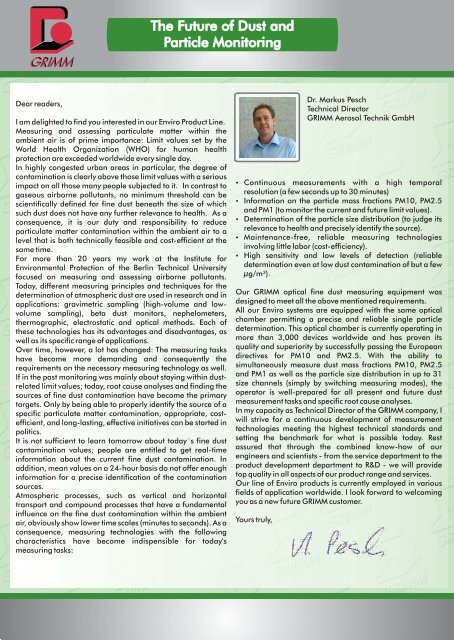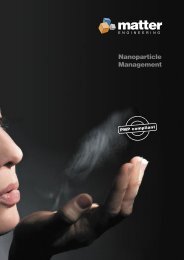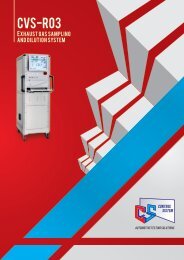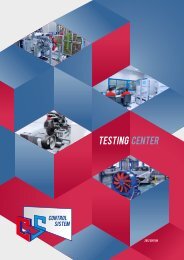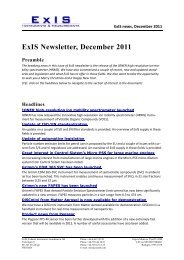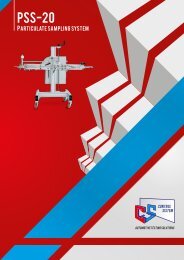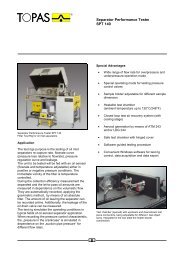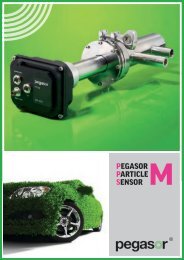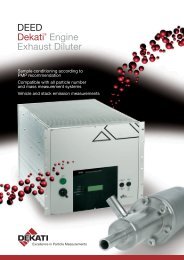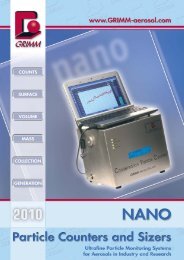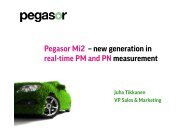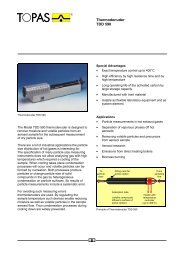Grimm EMD Catalogue - ExIS
Grimm EMD Catalogue - ExIS
Grimm EMD Catalogue - ExIS
You also want an ePaper? Increase the reach of your titles
YUMPU automatically turns print PDFs into web optimized ePapers that Google loves.
The Future of Dust and<br />
Particle Monitoring<br />
Dear readers,<br />
I am delighted to find you interested in our Enviro Product Line.<br />
Measuring and assessing particulate matter within the<br />
ambient air is of prime importance: Limit values set by the<br />
World Health Organization (WHO) for human health<br />
protection are exceeded worldwide every single day.<br />
In highly congested urban areas in particular, the degree of<br />
contamination is clearly above those limit values with a serious<br />
impact on all those many people subjected to it. In contrast to<br />
gaseous airborne pollutants, no minimum threshold can be<br />
scientifically defined for fine dust beneath the size of which<br />
such dust does not have any further relevance to health. As a<br />
consequence, it is our duty and responsibility to reduce<br />
particulate matter contamination within the ambient air to a<br />
level that is both technically feasible and cost-efficient at the<br />
same time.<br />
For more than 20 years my work at the Institute for<br />
Environmental Protection of the Berlin Technical University<br />
focused on measuring and assessing airborne pollutants.<br />
Today, different measuring principles and techniques for the<br />
determination of atmospheric dust are used in research and in<br />
applications: gravimetric sampling (high-volume and lowvolume<br />
sampling), beta dust monitors, nephelometers,<br />
thermographic, electrostatic and optical methods. Each of<br />
these technologies has its advantages and disadvantages, as<br />
well as its specific range of applications.<br />
Over time, however, a lot has changed: The measuring tasks<br />
have become more demanding and consequently the<br />
requirements on the necessary measuring technology as well.<br />
If in the past monitoring was mainly about staying within dustrelated<br />
limit values; today, root cause analyses and finding the<br />
sources of fine dust contamination have become the primary<br />
targets. Only by being able to properly identify the source of a<br />
specific particulate matter contamination, appropriate, costefficient,<br />
and long-lasting, effective initiatives can be started in<br />
politics.<br />
It is not sufficient to learn tomorrow about today´s fine dust<br />
contamination values; people are entitled to get real-time<br />
information about the current fine dust contamination. In<br />
addition, mean values on a 24-hour basis do not offer enough<br />
information for a precise identification of the contamination<br />
sources.<br />
Atmospheric processes, such as vertical and horizontal<br />
transport and compound processes that have a fundamental<br />
influence on the fine dust contamination within the ambient<br />
air, obviously show lower time scales (minutes to seconds). As a<br />
consequence, measuring technologies with the following<br />
characteristics have become indispensible for today's<br />
measuring tasks:<br />
Dr. Markus Pesch<br />
Technical Director<br />
GRIMM Aerosol Technik GmbH<br />
Continuous measurements with a high temporal<br />
resolution (a few seconds up to 30 minutes)<br />
Information on the particle mass fractions PM10, PM2.5<br />
and PM1 (to monitor the current and future limit values).<br />
Determination of the particle size distribution (to judge its<br />
relevance to health and precisely identify the source).<br />
Maintenance-free, reliable measuring technologies<br />
involving little labor (cost-efficiency).<br />
High sensitivity and low levels of detection (reliable<br />
determination even at low dust contamination of but a few<br />
µg/m³).<br />
Our GRIMM optical fine dust measuring equipment was<br />
designed to meet all the above mentioned requirements.<br />
All our Enviro systems are equipped with the same optical<br />
chamber permitting a precise and reliable single particle<br />
determination. This optical chamber is currently operating in<br />
more than 3,000 devices worldwide and has proven its<br />
quality and superiority by successfully passing the European<br />
directives for PM10 and PM2.5. With the ability to<br />
simultaneously measure dust mass fractions PM10, PM2.5<br />
and PM1 as well as the particle size distribution in up to 31<br />
size channels (simply by switching measuring modes), the<br />
operator is well-prepared for all present and future dust<br />
measurement tasks and specific root cause analyses.<br />
In my capacity as Technical Director of the GRIMM company, I<br />
will strive for a continuous development of measurement<br />
technologies meeting the highest technical standards and<br />
setting the benchmark for what is possible today. Rest<br />
assured that through the combined know-how of our<br />
engineers and scientists - from the service department to the<br />
product development department to R&D - we will provide<br />
top quality in all aspects of our product range and services.<br />
Our line of Enviro products is currently employed in various<br />
fields of application worldwide. I look forward to welcoming<br />
you as a new future GRIMM customer.<br />
Yours truly,


